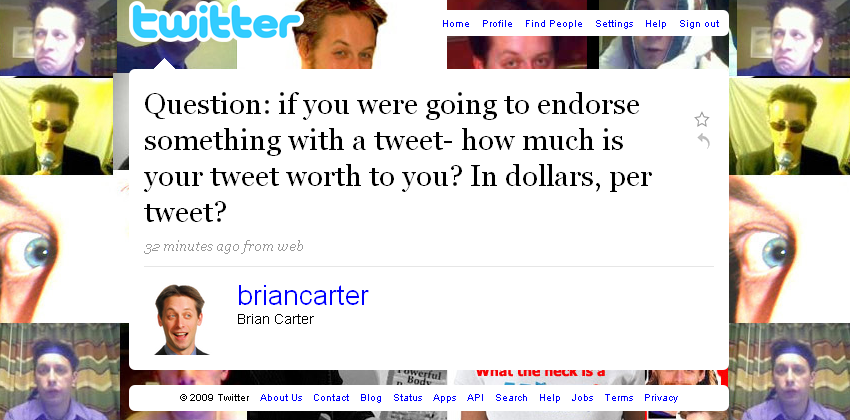Market value is a key commodity between businesses and their customers.
Word of mouth, both good and bad, is the currency behind the value.
What are your customers saying about you?
Advertising
Can I Buy You?
Brian Carter, a guy I admire immensely, raised an interesting question on Twitter today. He asked:
My own answer was, “It’s a moot point. If I like something enough to endorse it, I’d do it anyway for free. I wouldn’t sell my trust away.” Yet even as I said that, I wondered if I was looking at Brian’s question properly. Is an endorsement any different from a recommendation, or sponsorship?
Looking at the answers that Brian received, there was a definite mixed bag:
- “I endorse my friends and products for free.”
- “If I love the product and get a free sample, I would happily tweet for free.”
- “$1 a tweet.”
- “I’d say about fifty cents a tweet, $1 to include a link?”
- “It’s not the matter of the price of my tweet, it’s the price of the endorsement (which isn’t for sale.”
These are just some examples of the mixed reception the question got. (And I’m not saying any of them are right or wrong – these are just some typical examples of the mix). The fact that opinion seems to be evenly split is what makes me question when, or if, paid endorsement breaks the trust barrier?
To me, endorsing something is because you’ve used a product, service or person and you’re completely sold on it. You’re so taken with the results that you’ll wholeheartedly recommend it or them to your friends, family and colleagues. It’s the ultimate compliment – “It’s so good that I’m happy to use it.”
It’s the trust measurement that people who know and respect you will use when making decisions. So would a blind endorsement break that trust?
The fallout can be intensive when someone’s seen to have broken that trust measurement. You only need to look at the recent Izea sponsored posts outcry as an example. Trust is one of our most prized commodities and often it’s what separates us from contemporaries.
But is endorsing something in your Twitter stream for monetary gain any different from advertising on your blog? My own view says there is a difference. Usually you’re not approached by advertisers for a space on your blog (unless it’s a hugely popular one). I’m guessing paid endorsements would see vendors proactively buying your Twitter advertising space more than they might blog space.
Yet with the economy making things hard for people everywhere, should we question people’s rights to make money where they can? After all, we’re sensible enough to make our own decisions on whether a recommendation or endorsement is worth acting on, no?
What’s your take? Is your view for sale?
Don’t Tell Me – Sell Me!

I read a report today that women multi-task better than men. Published by Integrated Media Measurment Inc, the survey looked at how almost twice as many women both use the Internet and watch television at the same time compared to men.
While I found the survey a little obvious (everyone knows women multi-task better than men!),? it did make me wonder – how is this information being used?
Let’s look at the key group, for instance.
The biggest percentages of women that are using the Internet while watching TV are the ones that fall between the ages of 19 and 39. For this age group, many of the most popular shows include Grey’s Anatomy, Ugly Betty, Medium, 30 Rock and Big Shots.
This doesn’t take into account the most popular genres like soaps, lifestyle, reality TV and chat shows. So the question then becomes are brands using this audience effectively?
Media Convergence
Let’s say I’m the marketing director for one of these shows. I find out that while my target audience is watching the show, there’s a good chance that they’re also online at the same time. So shouldn’t I be using that to my advantage? How about…
- I offer fans of the show the option to register at my show’s website.
- When the show is on, anyone using the Internet at that time gets pinged with a time-sensitive message offering exclusive offers for the duration of the show. It could be fan apparel, memorabilia, discounts on DVD boxsets, etc.
- Pick random email addresses by location, give them free tickets to their favourite show and run their website username along the bottom of the screen as a way of saying, “Thanks for being a fan”.
These are the really obvious approaches and they’re also limited to first runs and live shows. Yet the concept is feasible and the technology is there. As far as costs go, take it a little step further with your advertisers. Show them the numbers of online users you have outreach to, and allow them to place similarly unique offers to those online users for a nominal fee increase in their advertising rates.
What do you think? Would you be interested in your favourite show or brand engaging you in this way? If not, and you fall into the group the IMMI survey mentions, what would you advise when it comes to brands interacting more with your online use?
If you enjoyed this post, please consider leaving a comment and subscribe to my RSS feed or via email to ensure you can enjoy the latest post(s).
Drop The Retainer If You Want to Retain
The day of the large retainer fee is over. Upfront and ongoing fees charged by PR, advertising and marketing agencies used to be the normal way to conduct business, but this is no longer the case. Truth be told, it hasn’t been the case for a while and more agencies need to realize this.
The massive stock crash and financial mire the economy finds itself in has affected everyone, from huge corporations to micro-businesses and everyone in-between. This has resulted in many companies either reigning in their agency spend or cutting ties altogether. The main reason for this has been the exorbitant retainer fees charged by many.
Smart agencies stopped this practice a long time ago, and changed over to value-based pricing. Instead of expensive monthly retainers and high hourly rates, value-based pricing charges on delivered results. This could be number of new customers, amount of new revenue, amount of press received, etc.
The benefit to the client is obvious – they aren’t shelling out for a monthly cost that may return very little. They also know that their agency is working properly for them – no results, no huge project fee regardless of success.
Many agencies decry value-based pricing, saying that it isn’t manageable and there are too many variants to take into account. I disagree – this is where getting to know your client comes in. You know, the role you’re being paid for?
As more businesses realize that high-cost retainers are becoming a thing of the past, the more they’ll look for agencies offering value-based alternatives. Will your agency be one?




![Reblog this post [with Zemanta]](http://img.zemanta.com/reblog_e.png?x-id=9f174bd3-a59b-4cd5-9483-f69f19de5086)

